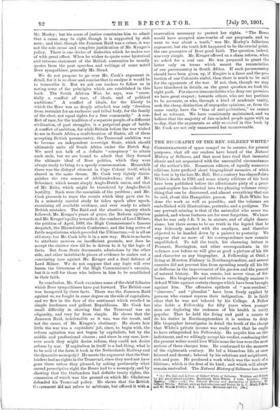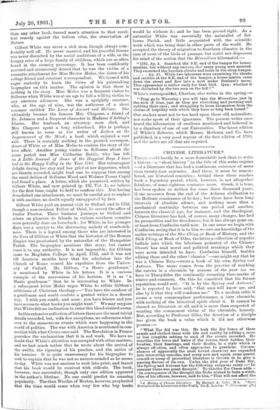THE BIOGRAPHY OF THE REV. GILBERT WHITE. 4 CONSIDERATIONS of space
compel us to assume, for present purposes, • that all our readers have heard of the Natural History of Selborne, and that most have read that immortal classic and are acquainted with the uneventful circumstance of the author's life. Numerous editors, of equally numerous editions, have prefixed short biographical memoirs, of which the best is by the late Mr. Bell. But a century has elapseesince White's death in 1793, and some ninety editions of his book have been published before the affectionate piety of a great- grand-nephew has collected into two pleasing volumes every. thing that can be discovered, and almost everything that can be said, about this Hampshire parson. Mr. Holt-White has done the work as well as possible; and the volumes are embellished with illustrations, portraits, and a pedigree. The one portrait missing is that of the naturalist who never was painted, and whose features are for ever forgotten. We know that he was only 5 ft. 3 in. in stature, and of slight dimen- sions; but there seems to be no truth in the legend that be was hideously marked with the smallpox, and therefore objected to be handed down by a painter to posterity. We suppose that no more of his correspondence now remains unpublished. To tell the truth, his charming letters to Pennant, Barrington, and other correspondents in the volumes now before us will give as good a picture of his life and character as any biographer. A Fellowship at Oriel, a living at Moreton Pall-my in Northamptonshire, and several curacies did not prevent him from spending nearly all his life at Selborne in the improvement of his garden and the pursuit of natural history. He was curate, but never vicar, of Sel- borne. His biographer and relative is exceedingly anxious to defend White against certain charges which have been brought against him. The offensive epithets of "non-resident," sinecure," and " pluralist " have been freely applied by persons who cannot repress their indignation. It is fairly clear that he was not beloved by his College. A Fellow who holds a Fellowship for fifty years when younger men are deploring the rudeness of his health is rarely popular. That he held the living and paid a curate to do his duties in Northamptonshire it is useless to deny. His biographer investigates in detail the truth of the charge that White's private income was really such that he ought to have relinquished his Fellowship. He acquits him on this indictment, and we willingly accept his verdict, confessing that the present writer would love White none the less were the most serious of these charges true. He conformed to the manners of the eighteenth century. He led a blameless life, at once leisured and decent; beloved by his relations and neighbours, rich and poor. He produced a work which was the work of s lifetime; which is the first of its kind ; and which will always remain unrivalled. The Natural History of Selborne has, more
• (1.) The Life and Letters of Gilbert White of Selborne. Written and Edited by is great-grand-nepbew, Rashleigh Holt-White. 2 vols. London : Johu y. 1328.]—(2.) The Natural History and Antiquities of Selborne. BY Gilbert White. Edited, with an Introduction and Notes, by L. C. Mall, r-B•S" and W. Wards Fowler, M.A. London: Methuen and Co. f6s.]
than any other book, turned men's attention to that excel- lent remedy ago inst the tedium vitae, the observation of Nature.
Gilbert White was never a rich man, though always com- fortably well off. He never married, and his peaceful leisure was never disturbed by the social ambitions of a wife, or the hungry cries of a large family of children, which are so often heard in the country parsonage. It has been confidently asserted and strenuously denied that he was the victim of a romantic attachment for Miss Hester Mulso, the sister of his college friend and constant correspondent. We turned with eager curiosity to learn the views of his painstaking biographer on this matter. The opinion is that there is nothing in the story. Miss Mulso was a frequent visitor to Selborne when White was at an age to fall a willing victim to any amorous advances. She was a sprightly creature, who, at the age of nine, was the authoress of a short romance entitled The Loves of Amoret and Melissa. She ultimately became the famous Mrs. Chapone, a friend of Dr. Johnson and a frequent character in Madame d'Arblay's Diaries. Her husband, an attorney, soon died, and Mrs. Chapone spent a long widowhood. She is perhaps still known to some as the writer of Letters on the Improvement of the Mind ; a book which enjOyed a vast sale. There is certainly nothing in the printed cormspon. deuce of White or of Miss Mulso to confirm the story of the love affair. Another young visitor to Selborne about the same period was Miss Catharine Bettie, who has left us .A. Little Journal of Some of the Happiest Days I have had in the Happy Valley in the Year 1763. Her extravagant delight during her stay and her grief at her departure, which are therein recorded, might lead one to suppose that among the rural deities of Selborne Wood and Wolmer Forest Cupid had found a place. A letter, which she preserved, written by Gilbert White, and now printed (p. 132, Vol. 1), we believe for the first time, might be held to confirm this. But having demolished one attachment., we must be careful not to replace it with another, no doubt equally unsupported by fact.
Gilbert White paid an annual visit to Oxford, and in 1752, though a non-resident Fellow of Oriel, he served the office of Junior Proctor. These business journeys to Oxford and others on pleasure to friends in various southern counties were generally done on horseback ; for White, in his younger days, was a martyr to the distressing malady of coach-sick- ness. There is a legend among those who are interested in the lives of Gibbon or White that the historian of the Roman Empire was proctorised by the naturalist of the Hampshire Parish. The biographer mentions this story, but cannot trace it to any authority. It is not impossible ; for Gibbon came to Magdalen College in April, 1752, and it was not till fourteen months later that his admission into the Church of Rome caused his expulsion from the Univer- sity of Oxford. Mr. Gibbon, "a Hants gentleman," is mentioned by White in his letters. It is a curious example of the narrowness of his horizon. It is as "a Hants gentleman" that he is interesting to White. In a subsequent letter Mulso urges White to refute Gibbon's criticisms of Christian theology :—" You have the candour of a gentleman and could confute a genteel writer in a decent way. I wish you could; and soon : you have leisure and you have access to what books you might want." We may suppose that White felt no inclination to enter this blood-stained arena.
In this extensive collection of letters there are the most trivial details recorded, but, with few exceptions, no references what- ever to the momentous events which were happening in the world of politics. The war with America is mentioned in con- nection with what Cicero once said. The Revolution in France provokes the exclamation that it is sad work. We have no doubt that White's attention was occupied with other matters; and we had much rather that he wrote about the arrival of the swifts, the ripening of his peaches, and. the antics of his tortoise. It is quite unnecessary for his biographer to seek to explain that he was not so narrow-minded as he seems to-day. White was not anxious to rush into print, and feared that his book would be received with ridicule. The book, however, was successful; though only one edition appeared in the author's lifetime. No one could predict its amazing Popularity. The then Warden of Merton, however, prophesied that the time would come When very' few who. buy: books would be without it ; and he has been proved right. As a naturalist White was essentially the naturalist of Sel- borne Parish, and little acquainted with the scientific work which was being done in other parts of the world. He accepted the theory of migration to Southern climates in the case of most of the birds of passage, but could not dispossess his mind of the notion that the Hirundines hibernated :—
" 1781, Ap. 5. Searched the S.E. end of the hanger for house- martins, but without any success, tho' many young men assisted. They examined the beechen-shrubs and holes in the steep hanger.
A p. 11. While two labourers were examining the shrubs and cavities at the S.E. end of the banger, a house-martin came down the street and flew into a nest under Benham's eaves. This appearance is rather early for that bird. Qum: whether it was disturbed by the two men on the hill I"
White's correspondint, Churton, also writes in the spring :—
" Pray go to Waverley ; you will take the Hirundines just in the nick of time, just as they are stretching and yawning and rubbing their eyes; and struggling to loose themselves from the chains of torpidity with which they have so long been bound."
Our readers must not be it* hard upon these old naturalists, nor make sport of their ignorance. The present writer once heard the hibernation of swallows mentioned and believed in by a dignitary of one of our Universities. The latest edition of White's Selborne, which Messrs. Methuen and Co. have published, is a very good reprint of the first edition of 1789, and the notes are all that are required.



































 Previous page
Previous page